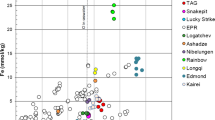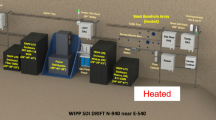Abstract
This paper, the third in our sequence on a model geothermal brine based on a H2O-NaCl system, proposes correlations for the thermodynamic properties of specific enthalpy and dynamic viscosity of brine. It follows a similar pattern to the second paper on the density correlations, that is formulae which closely approximate the specific enthalpy and dynamic viscosity are given in terms of the primary variables T (temperature), p (pressure) and X (mass fraction of sodium chloride). These correlations cover the entire T-p-X state-space and together with the density correlations, can be used in subroutines suitable for use in numerical simulation programs.
Similar content being viewed by others
References
Alkan, H., Babadagli, T. and Satman, A.: 1995, The prediction of the PVT/phase behaviour of the geothermal fluid mixtures, In: Proc. World Geothermal Congress, International Geothermal Association, pp. 1659–1665.
Battistelli, A., Calore, C. and Pruess, K.: 1997, The simulator TOUGH2/EWASG for modelling geothermal reservoirs with brines and non-condensible gas, Geothermics 26(4), 437–464.
Ershaghi, I., Abdassah, D., Bonakdar, M. and Ahmad, S.: 1983, Estimation of geothermal brine viscosity, J. Petrol. Technol. March, pp. 621–628.
Haas, J. L. and Potter, R.W.: 1977, The measurement and evaluation of PVTX properties of geothermal brines and the derived thermodynamic properties, In: Proc. Symp. Thermophys. Prop., pp. 604–614.
Herbert, A. W., Jackson, C. P. and Lever, D. A.: 1988, Coupled groundwater flow and solute transport with fluid density strongly dependent upon concentration, Water Resour. Res. 24(10), 1781–1795.
James, A. M. and Lord, M. P.: 1992, MacMillan's Chemical and Physical Data, MacMillan, London.
Janz, G. J.: 1988, Thermodynamic and transport properties of molten salts: correlation equations for critically evaluated density, surface tension, electrical conductance, and viscosity data, J. Phys. Chem. Ref. Data 17(2).
Kaufmann, D. W. (ed.): 1968, Sodium Chloride the Production and Properties of Salt and Brine, chapter 25, American Chemical Society Monograph Series, Hafner, New York.
Kissling, W. M.: 1995, Extending MULKOM to super-critical temperatures and pressures, In: Proc. World Geothermal Congress, International Geothermal Association, pp. 1687–1690.
Lide, D. R. (ed.): 1996, CRC Handbook of Chemistry and Physics, CRC Press, 77th edn, pp. 8–73.
McKibbin, R. and McNabb, A.: 1993, Modelling the phase boundaries and fluid properties of the system H2O-NaCl at high temperatures and pressures, In: Proc. 15th New Zealand Geothermal Workshop, University of Auckland, pp. 267–273.
McKibbin, R. and McNabb, A.: 1995, Mathematical modelling of non-condensible gases in hot dense brines: the system H2O-NaCl-CO2, In: Proc. 17th New Zealand Geothermal Workshop, University of Auckland, pp. 255–262.
McNabb, A., White, S. and McKibbin, R.: 1993, Brine circulation and hot-plate formation, In: Proc. 15th New Zealand Geothermal Workshop, University of Auckland, pp. 275–277.
Michaelides, E. E.: 1981, Thermodynamic properties of geothermal fluids, Geotherm. Resour. Council Transactions 5, Oct., 361–364.
Oldenburg, C., Pruess, K. and Lippmann, M.: 1995, Heat and mass transfer in hypersaline geothermal systems, In: Proc. World Geothermal Congress, International Geothermal Association, pp. 1647–1652.
Palliser, C. C. and McKibbin, R.: 1998a, A model for deep geothermal brines, I: T-p-X state-space description, Submitted for publication.
Palliser, C. C. and McKibbin, R.: 1998b, A model for deep geothermal brines, II: Thermodynamic properties — density, Submitted for publication.
Palliser, C. C.: 1998, A model for deep geothermal brines: state space description and thermodynamic properties, PhD thesis.
Phillips, S. L., Igbene, A., Fair, J. A., Ozbek, H. and Tavana, M.: 1981, A technical databook for geothermal energy utilization, Lawrence Berkeley Laboratory, University of California, Berkeley, CA 94720.
Pitzer, K. S., Peiper, J. C. and Busey, R. H.: 1983, Thermodynamic properties of aqueous sodium chloride solutions, Technical report, Lawrence Berkeley Laboratory and Oak Ridge National Laboratory, Feb. 1983.
Potter, R. W.: 1978, Viscosity of geothermal brines, Geotherm. Resour. Council, Transactions 2, 543–544.
Saul, A. and Wagner, W.: 1989, A fundamental equation for water covering the range from the melting line to 1273 K at pressures up to 25000 MPa, J. Phys. Chem. Ref. Data 18(4), 1537–1564.
Schmidt, E.: 1979, Properties of Steam and Water in SI-Units, Springer-Verlag, p. 190.
Stull, D. R. and Prophet, H. (ed.): 1971, JANAF Thermochemical Tables, U.S. Department of Commerce, National Bureau of Standards, 2nd edn.
Tanger, J. C. and Pitzer, K. S.: 1989, Thermodynamics of NaCl-H2O: a new equation of state for the near-critical region and comparisons with other equations for adjoining regions, Geochimica et Cosmochimica Acta 53, 973–987.
White, S. P. and Kissling, W. M.: 1992, Modelling geothermal reservoirs, recent developments, In: Proc. 14th New Zealand Geothermal Workshop, University of Auckland, pp. 99–104.
Author information
Authors and Affiliations
Rights and permissions
About this article
Cite this article
Palliser, C., McKibbin, R. A Model for Deep Geothermal Brines,III: Thermodynamic Properties – Enthalpy and Viscosity. Transport in Porous Media 33, 155–171 (1998). https://doi.org/10.1023/A:1006549810989
Issue Date:
DOI: https://doi.org/10.1023/A:1006549810989




